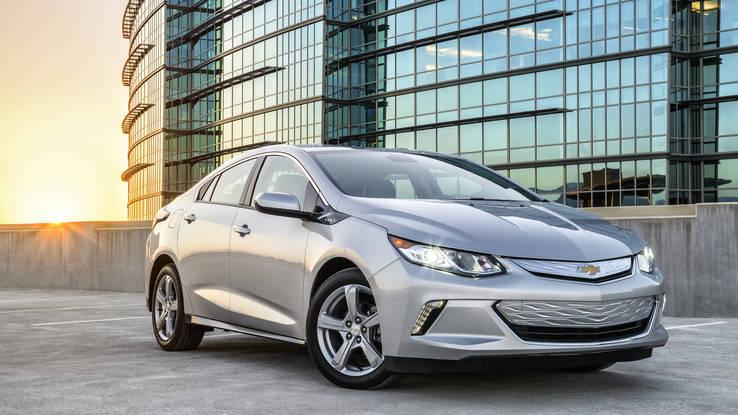Chevy’s plug-in hybrid goes further on a charge and looks better doing it
What is it? Just ahead of the next Toyota Prius (coincidence?), the second generation of Chevy’s hybrid Volt rolls into showrooms with pretty much everything on it new, including the hybrid drive system, transmission, interior and exterior. Battery capacity is up to 18.4 kWh compared to 17.1 on last year’s Volt and 16.5 before that. An all-new 111-kW electric drive unit uses two electric motors working with planetary gear sets to mix-n-match power delivery depending on need. The drive unit itself is 100 pounds lighter than before. The four-cylinder gasoline direct-injection engine goes up in displacement from 1.4 liters to 1.5 but down in exterior size and weight. With direct injection and a compression ratio of 12.5:1, the gasoline engine makes 101 hp on regular gas.
The exterior of the 2016 Volt is all-new, too: Chief engineer Andrew Farah called it sleeker and smoother, saying, “If the metal was left out in the desert and the wind was blowing it like sand, what would it look like?”
Uh, like sand-blasted metal? The changes are subtle but pleasing.
Inside, the new Volt looks less like an IKEA men’s room art project and more like a comfortable daily driver. Gone is the weirdo haptic-feedback center console, replaced with a more traditional-looking interface. The back seat can now accommodate three passengers, or two if the center armrest is deployed.
EPA range for pure electric driving is now a whopping 53 miles, a 40 percent increase over the outgoing Volt.

The Volt is all-new inside, outside and under the hood.
What’s it like to drive?
The first thing you want to do with a drivetrain like this is play around with that electric range. Jumping into our first 2016 Volt, the range readout before we left promised 52 miles on batteries alone. Driving conservatively (but not hypermiling) over mostly flat ground -– one pass was 1,808 feet high –- we managed 54 miles before the gasoline engine kicked in. On the next “tankful” of battery we got 61.5 miles in EV mode, but that was downhill for most of the first 10 miles, so maybe saying 51 miles would be more accurate there. There’s a regen-on-demand tab on the steering wheel that increases the amount of regenerative braking from the drive unit and allows you to tailor your driving to get more out of the battery. The EPA’s estimate of 53 miles on electricity seems entirely plausible. GM engineers say 70-mile range on batteries alone is not unheard of, but we don’t know how you’d get that.
When you’re not trying to hypermile, you’ll find acceleration can be brisk. Chevy claims 0-60 in 8.4 seconds, which beats a Prius by a couple seconds. It also feels a lot more connected to the road than a Prius. It’s not what you’d call sporty but if you had to choose and you wanted the car that was more fun to drive you’d get the Volt. The Ford Fusion plug-in hybrid is also close to the Volt in driving feel, though we might still choose a Volt for handling.
The new Volt is noticeably quieter than the previous model and a lot more livable with its new interior. The only thing we’d warn against is the light grey interior trim, which turns the dashboard into a sunlight-reflecting driver-blinder. Get the darkest interior you can find on the dealer’s lot.

The Volt’s exterior gets a 0.28 cd.
Do I want it?
It’s certainly more fun to drive than any of the Prii and even looks a little more stylish, in the three-box style of mass-market sedans. However, since the Volt’s debut at the very end of 2010, Chevy has only managed to sell 77,000 units, while Toyota sold well over 100,000 Priuses through July of this year alone. The starting sticker price is $ 33,995, which, after you start tabulating government rebates, works out to as low as $ 24,995 in rebate-happy states like California. And you can “buy American.”





























